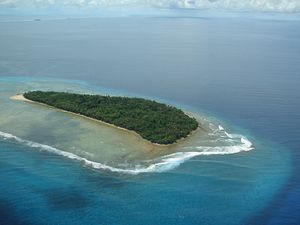The Marshall Islands has declared a state of national emergency, citing its severe drought conditions as one of the worst disasters to ever befall the archipelago nation.
The announcement was made by President Hilda Heine on February 4, only a few days after she was elected leader of the Nitijeļā, the Marshall Islands Legislature. Heine has been thrown into the deep end, as the nation continues to be battered not only by giant waves but also by sustained drought conditions, courtesy of a protracted El Niño system that started building up in early 2015 and has shown no signs of relenting.
The country depends on rainfall for over 90 percent of its water supplies, and yet has received approximately a quarter of its usual rainfall during the November-February period. The capital Majuro is down to its trace water reserves. Water is being meted out in the city only once per week for a four-hour period, forcing each family to allocate their water reserves carefully to last them into the following week. Even the water pooling on the capital’s runway is not wasted, with the precious runoff serving to tide citizens by just that little bit longer until the drought breaks.
The Marshallese are no strangers to drought. The last severe drought hit the country in 2013, with 5000 Marshallese in the northern atolls enduring severe drought conditions and a further 11,000 suffering from food and water shortages. With a national population of some 50,000 people, virtually every family in the Marshall Islands has faced the harsh reality of chronic water scarcity.
In a good year, the southern atolls of the country generally receive about one hundred inches of rainfall, whilst the northern atolls receive approximately 50 inches. While fresh water is never exactly abundant in the islands, communities generally get by from year to year by relying on the rainwater collected from their own roofs coupled with their network of natural underground reservoirs. As the drought worsens, however, the salt water level at the bottom of the reservoirs will contaminate what little fresh groundwater reserves remain, forcing citizens to turn to the dwindling municipal water supply back in Majuro.
The purpose of calling the national emergency is to bring the drought more international attention, with Heine hoping that the declaration will bring in more international aid and resources to cope with the crisis. In 2013 the U.S. government gave some $5.5 million in drought relief – the least it could do in the wake of the catastrophic legacy left by the Operation Crossroads nuclear tests it conducted from 1946-1954, which permanently contaminated many of the islands’ water sources. Whilst the Marshallese government has done its best to install a number of desalination units, these machines are expensive to obtain and run. A typical diesel fuelled generator will produce between $30,000 and $75,000 per year in fuel costs alone. In any case, the islands require many more units to reverse the grave public health risks posed by water scarcity.
The Marshall Islands is not the only nation amongst the Pacific islands suffering from extreme drought; the same El Niño system is currently afflicting Micronesia, Palau, Fiji and Papua New Guinea with varying levels of severity, and is predicted to last well until the second half of this year. The incidence of extreme weather events in the Marshall Islands has been heightened by the system, with freak waves, king tides, soil erosion, crop damage and grassfires occurring as just some of the bonus effects of the drought. As the international community lumbers toward implementing the promises made at COP 21, the anger directed by Pacific leaders toward the inaction of Australian policymakers is hardly surprising. Meanwhile, Heine can but hope that her announcement will generate a few more desalination units.
Sally Andrews is a New Colombo Plan Scholar and the 2015-2015 New Colombo Plan Indonesia Fellow. She is a Director of the West Papuan Development Company and contributes to the Insights blog as part of her work as the 2016 Indo-Pacific Fellow for Young Australians in International Affairs. This article was published on the Young Australians in International Affairs blog. It is reprinted with kind permission.

































